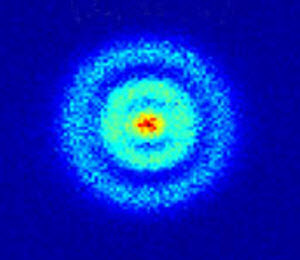Electrons and the Periodic Table
An atom is a system of one or more electrons bound to a nucleus. Here is a quantum microscope image of a hydrogen atom:

https://dx.doi.org/10.1103/PhysRevLett.110.213001
Hydrogen has just one electron, which exists as a fuzzy probability cloud.
But it is easier to use a simple diagram:
Electrons are attracted to protons, and are in their lowest energy state:
- each wider "shell" (any dashed circle shown below) has a higher energy state
- within each shell there are also different energy states called orbitals (we give special colors in the animation)
- each orbital has at most two electrons together (with opposite spin)
Play with it below ... try selecting different elements to see how electron configurations change. Can you spot any patterns or similarities?
The electrons don't always go where you expect. It is like packing things into a box, the items find their lowest energy locations, sometimes with subtle shifting going on.
It Causes Chemistry!
But the really cool thing is that the outermost electrons affect how each element bonds or reacts chemically with others.
Examples:
- Hydrogen (H) likes to bond (with itself and others) as it has an empty electron spot
- Helium (He) finds bliss without bonding, as its two electrons fill its first shell
- Lithium (Li), similar to Hydrogen, likes to bond as it has one empty electron spot in its outer shell
- etc
And so it makes sense to group all elements that behave in a similar way into columns (called groups).
And the rows (called periods) show us how many shells.
There are also 4 main blocks that correspond roughly with the type of orbital (shown as the color of the block).Have another play with the table and more for yourself.
(Note: the block starting at 57 etc belongs in the table next to number 56. And the block starting at 89 etc belongs in the table next to number 88.)
Conclusion:
- electrons naturally seek their lowest energy level around the nucleus
- the resulting outermost electrons are the main cause of chemistry!